Zylla Limited: Analysis of Finance Sources and Investment Appraisal
VerifiedAdded on 2023/06/14
|11
|2915
|149
Report
AI Summary
This report analyzes Zylla Limited, a transportation service provider aiming to expand by acquiring a new ferry. It explores short-term finance options like trade credit and lease financing, alongside long-term sources such as retained earnings and loans from financial institutions. The report evaluates investment appraisal techniques, specifically the payback period method, to assess the financial viability of the ferry acquisition. It details the advantages and disadvantages of each financing source, including the impact on company assets, ownership, and operational flexibility. The analysis provides Zylla Limited with a framework for making informed financial decisions regarding its expansion strategy, highlighting the importance of balancing acquisition costs with working capital needs and considering the long-term financial implications of each choice. Desklib provides access to similar solved assignments and study resources for students.

Coursework 1 and 2
1
1
Paraphrase This Document
Need a fresh take? Get an instant paraphrase of this document with our AI Paraphraser

Content
INTRODUCTION...........................................................................................................................3
MAIN BODY...................................................................................................................................3
Maslow’s Hierarchy of needs.................................................................................................3
Skinner’s reinforcement theory of motivation.......................................................................5
CONCLUSION................................................................................................................................7
TASK 4............................................................................................................................................8
INTRODUCTION...........................................................................................................................8
MAIN BODY...................................................................................................................................8
Sources of finance for the company.......................................................................................8
Evaluation of investment appraisal techniques for the company...........................................9
CONCLUSION..............................................................................................................................11
REFRENCES.................................................................................................................................12
2
INTRODUCTION...........................................................................................................................3
MAIN BODY...................................................................................................................................3
Maslow’s Hierarchy of needs.................................................................................................3
Skinner’s reinforcement theory of motivation.......................................................................5
CONCLUSION................................................................................................................................7
TASK 4............................................................................................................................................8
INTRODUCTION...........................................................................................................................8
MAIN BODY...................................................................................................................................8
Sources of finance for the company.......................................................................................8
Evaluation of investment appraisal techniques for the company...........................................9
CONCLUSION..............................................................................................................................11
REFRENCES.................................................................................................................................12
2

INTRODUCTION
The focus of motivation in a business context is to create an environment in which every
employee is able to attain their highest potential and contribute maximum productivity to the
company (Altinay et. al., 2019). The increasing importance of human capital in the contemporary
business environment has increased the importance of maintaining workforce motivation and
different theories are used by organizations to ensure that employee motivation remains high.
This report is based on the case study of Tesco management who are looking for effective
motivational theories which can be used to ensure that employees of the new discount store
Jack’s remain highly motivated. This report evaluates different motivational theories which can
be used to support management at Tesco in improving employee motivation at Jack’s discount
stores.
MAIN BODY
Maslow’s Hierarchy of needs
The content theories of motivation focus on the reason behind motivation of an individual
and looks at the basic needs of an individual. The motivational theories included under the
content models of motivation assume that people's motivations will be based on acquiring the
things that they think they need and by understanding their wants and needs the reason for
motivation of an individual can be determined. Maslow’s hierarchy of needs divides basic needs
of an individual into a hierarchy which provides high motivation upon fulfillment of each need
according to the order of the hierarchy (De Sousa Sabbagha, Ledimo and Martins, 2018). They
need to described in this city are pretty all physiological needs Safety needs love and belonging
needs esteem needs and self-actualization needs. This motivation theory can be utilized by
management at Tesco to ensure that the needs of employees at Jack’s are fulfilled effectively and
they are able to reach the highest level of motivation. The ways in which jack’s can apply this
motivational theory is explained below:
Physiological needs: In the first level of Maslow's hierarchy of needs
basic requirements which are needed for sustaining life of an individual are covered. This
involves the foundational requirements of food shelter and water which are needed by every
individual. In order to fulfill this level of need management at Tesco needs to that every
employee gains minimum wage needed to secure food shelter and water and is also given
3
The focus of motivation in a business context is to create an environment in which every
employee is able to attain their highest potential and contribute maximum productivity to the
company (Altinay et. al., 2019). The increasing importance of human capital in the contemporary
business environment has increased the importance of maintaining workforce motivation and
different theories are used by organizations to ensure that employee motivation remains high.
This report is based on the case study of Tesco management who are looking for effective
motivational theories which can be used to ensure that employees of the new discount store
Jack’s remain highly motivated. This report evaluates different motivational theories which can
be used to support management at Tesco in improving employee motivation at Jack’s discount
stores.
MAIN BODY
Maslow’s Hierarchy of needs
The content theories of motivation focus on the reason behind motivation of an individual
and looks at the basic needs of an individual. The motivational theories included under the
content models of motivation assume that people's motivations will be based on acquiring the
things that they think they need and by understanding their wants and needs the reason for
motivation of an individual can be determined. Maslow’s hierarchy of needs divides basic needs
of an individual into a hierarchy which provides high motivation upon fulfillment of each need
according to the order of the hierarchy (De Sousa Sabbagha, Ledimo and Martins, 2018). They
need to described in this city are pretty all physiological needs Safety needs love and belonging
needs esteem needs and self-actualization needs. This motivation theory can be utilized by
management at Tesco to ensure that the needs of employees at Jack’s are fulfilled effectively and
they are able to reach the highest level of motivation. The ways in which jack’s can apply this
motivational theory is explained below:
Physiological needs: In the first level of Maslow's hierarchy of needs
basic requirements which are needed for sustaining life of an individual are covered. This
involves the foundational requirements of food shelter and water which are needed by every
individual. In order to fulfill this level of need management at Tesco needs to that every
employee gains minimum wage needed to secure food shelter and water and is also given
3
⊘ This is a preview!⊘
Do you want full access?
Subscribe today to unlock all pages.

Trusted by 1+ million students worldwide
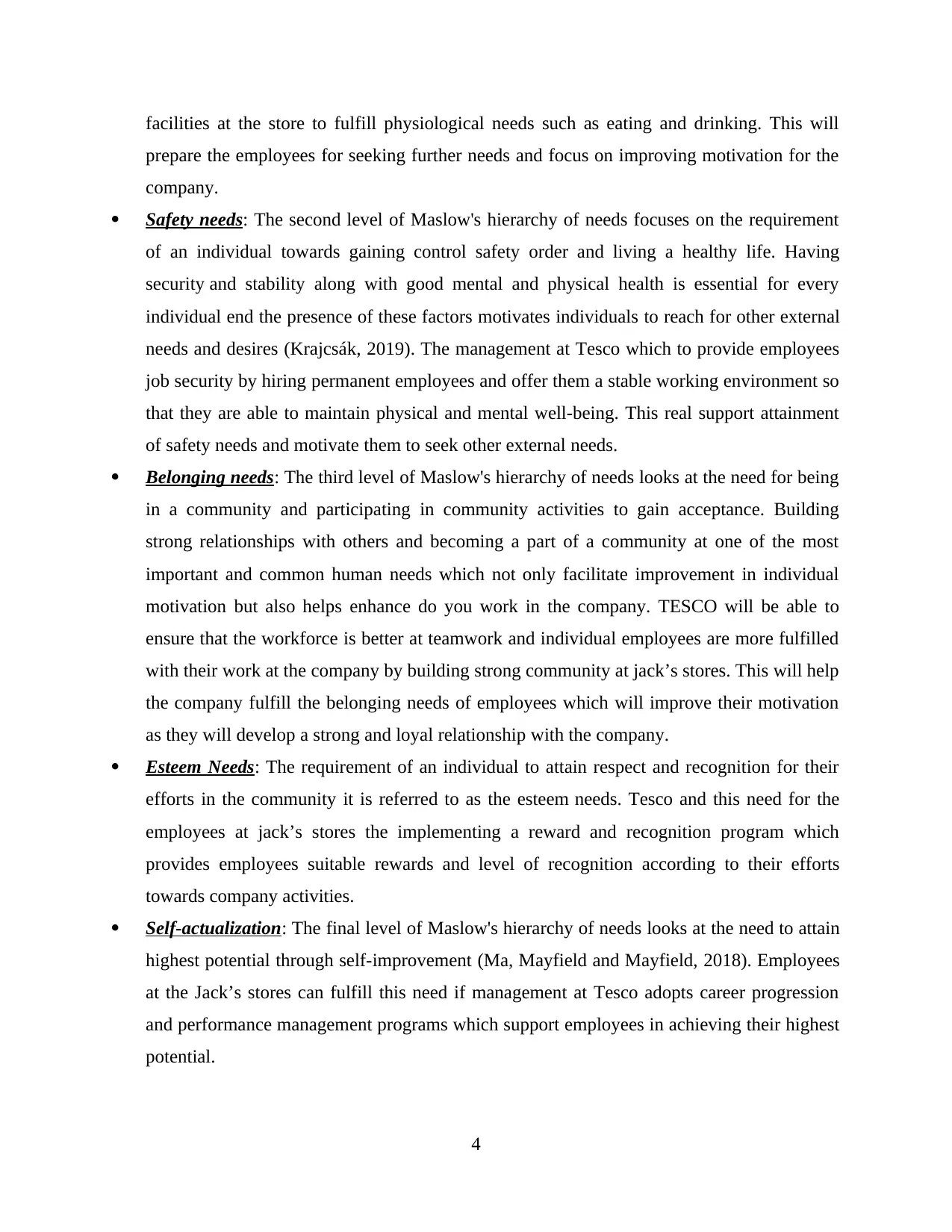
facilities at the store to fulfill physiological needs such as eating and drinking. This will
prepare the employees for seeking further needs and focus on improving motivation for the
company.
Safety needs: The second level of Maslow's hierarchy of needs focuses on the requirement
of an individual towards gaining control safety order and living a healthy life. Having
security and stability along with good mental and physical health is essential for every
individual end the presence of these factors motivates individuals to reach for other external
needs and desires (Krajcsák, 2019). The management at Tesco which to provide employees
job security by hiring permanent employees and offer them a stable working environment so
that they are able to maintain physical and mental well-being. This real support attainment
of safety needs and motivate them to seek other external needs.
Belonging needs: The third level of Maslow's hierarchy of needs looks at the need for being
in a community and participating in community activities to gain acceptance. Building
strong relationships with others and becoming a part of a community at one of the most
important and common human needs which not only facilitate improvement in individual
motivation but also helps enhance do you work in the company. TESCO will be able to
ensure that the workforce is better at teamwork and individual employees are more fulfilled
with their work at the company by building strong community at jack’s stores. This will help
the company fulfill the belonging needs of employees which will improve their motivation
as they will develop a strong and loyal relationship with the company.
Esteem Needs: The requirement of an individual to attain respect and recognition for their
efforts in the community it is referred to as the esteem needs. Tesco and this need for the
employees at jack’s stores the implementing a reward and recognition program which
provides employees suitable rewards and level of recognition according to their efforts
towards company activities.
Self-actualization: The final level of Maslow's hierarchy of needs looks at the need to attain
highest potential through self-improvement (Ma, Mayfield and Mayfield, 2018). Employees
at the Jack’s stores can fulfill this need if management at Tesco adopts career progression
and performance management programs which support employees in achieving their highest
potential.
4
prepare the employees for seeking further needs and focus on improving motivation for the
company.
Safety needs: The second level of Maslow's hierarchy of needs focuses on the requirement
of an individual towards gaining control safety order and living a healthy life. Having
security and stability along with good mental and physical health is essential for every
individual end the presence of these factors motivates individuals to reach for other external
needs and desires (Krajcsák, 2019). The management at Tesco which to provide employees
job security by hiring permanent employees and offer them a stable working environment so
that they are able to maintain physical and mental well-being. This real support attainment
of safety needs and motivate them to seek other external needs.
Belonging needs: The third level of Maslow's hierarchy of needs looks at the need for being
in a community and participating in community activities to gain acceptance. Building
strong relationships with others and becoming a part of a community at one of the most
important and common human needs which not only facilitate improvement in individual
motivation but also helps enhance do you work in the company. TESCO will be able to
ensure that the workforce is better at teamwork and individual employees are more fulfilled
with their work at the company by building strong community at jack’s stores. This will help
the company fulfill the belonging needs of employees which will improve their motivation
as they will develop a strong and loyal relationship with the company.
Esteem Needs: The requirement of an individual to attain respect and recognition for their
efforts in the community it is referred to as the esteem needs. Tesco and this need for the
employees at jack’s stores the implementing a reward and recognition program which
provides employees suitable rewards and level of recognition according to their efforts
towards company activities.
Self-actualization: The final level of Maslow's hierarchy of needs looks at the need to attain
highest potential through self-improvement (Ma, Mayfield and Mayfield, 2018). Employees
at the Jack’s stores can fulfill this need if management at Tesco adopts career progression
and performance management programs which support employees in achieving their highest
potential.
4
Paraphrase This Document
Need a fresh take? Get an instant paraphrase of this document with our AI Paraphraser

The main advantage of using Maslow's hierarchy of needs as the motivational theory for
improving motivation of employees at jack’s stores is that it helps the company identify the
basic requirements which need to be fulfilled in order to attain high motivation. In addition
to this the company will also not make mistake in trying to fulfill the higher needs in the
hierarchy before the lower needs which will not provide the desired result in terms of
improvement in employee motivation. The main disadvantage of the motivational theory is
that there is a lot of this theory is affected by the culture of the organization region in which
the employees work (Noor and et. al., 2020). In addition to this there is lack of empirical
evidence stating the effectiveness of this theory in delivering desired results.
Skinner’s reinforcement theory of motivation
According to this motivational theory the behavior of an individual is related to the consequences
of the action and is based on law and effect. This means that individuals repeat actions and
behaviors which have positive consequences while avoid behaviors which lead to negative
consequences. Under this theory external environment of an organization is controlled in order to
create an environment which facilitates positive behaviors and help employees reduce negative
behaviors. the four methods which are described in this story to enhance employee motivation
are described below:
Positive Reinforcement: This involves giving a positive response to an individual when
positive and required behavior is shown.
Negative Reinforcement: This involves rewarding an employee by removing negative or
undesirable consequences.
Punishment: This is accomplished by elimination of positive consequences in order to
minimize the probability of repetition of undesirable behavior in the future.
Extinction: In this method the reward for an undesirable behavior are eliminated so as to
not support the repetition of that behavior (Xiong and King, 2019).
The advantage of this motivation theory is that it can improve employee morale reduce turn over
and enhance productivity of the employees by creating a positive working environment. Apart
from this, it helps employees build positive behavior. The disadvantages of this theory are that it
reduces creativity of the company and also neglects the feelings of the employee which can
negatively affect relation between the company and the employee.
5
improving motivation of employees at jack’s stores is that it helps the company identify the
basic requirements which need to be fulfilled in order to attain high motivation. In addition
to this the company will also not make mistake in trying to fulfill the higher needs in the
hierarchy before the lower needs which will not provide the desired result in terms of
improvement in employee motivation. The main disadvantage of the motivational theory is
that there is a lot of this theory is affected by the culture of the organization region in which
the employees work (Noor and et. al., 2020). In addition to this there is lack of empirical
evidence stating the effectiveness of this theory in delivering desired results.
Skinner’s reinforcement theory of motivation
According to this motivational theory the behavior of an individual is related to the consequences
of the action and is based on law and effect. This means that individuals repeat actions and
behaviors which have positive consequences while avoid behaviors which lead to negative
consequences. Under this theory external environment of an organization is controlled in order to
create an environment which facilitates positive behaviors and help employees reduce negative
behaviors. the four methods which are described in this story to enhance employee motivation
are described below:
Positive Reinforcement: This involves giving a positive response to an individual when
positive and required behavior is shown.
Negative Reinforcement: This involves rewarding an employee by removing negative or
undesirable consequences.
Punishment: This is accomplished by elimination of positive consequences in order to
minimize the probability of repetition of undesirable behavior in the future.
Extinction: In this method the reward for an undesirable behavior are eliminated so as to
not support the repetition of that behavior (Xiong and King, 2019).
The advantage of this motivation theory is that it can improve employee morale reduce turn over
and enhance productivity of the employees by creating a positive working environment. Apart
from this, it helps employees build positive behavior. The disadvantages of this theory are that it
reduces creativity of the company and also neglects the feelings of the employee which can
negatively affect relation between the company and the employee.
5
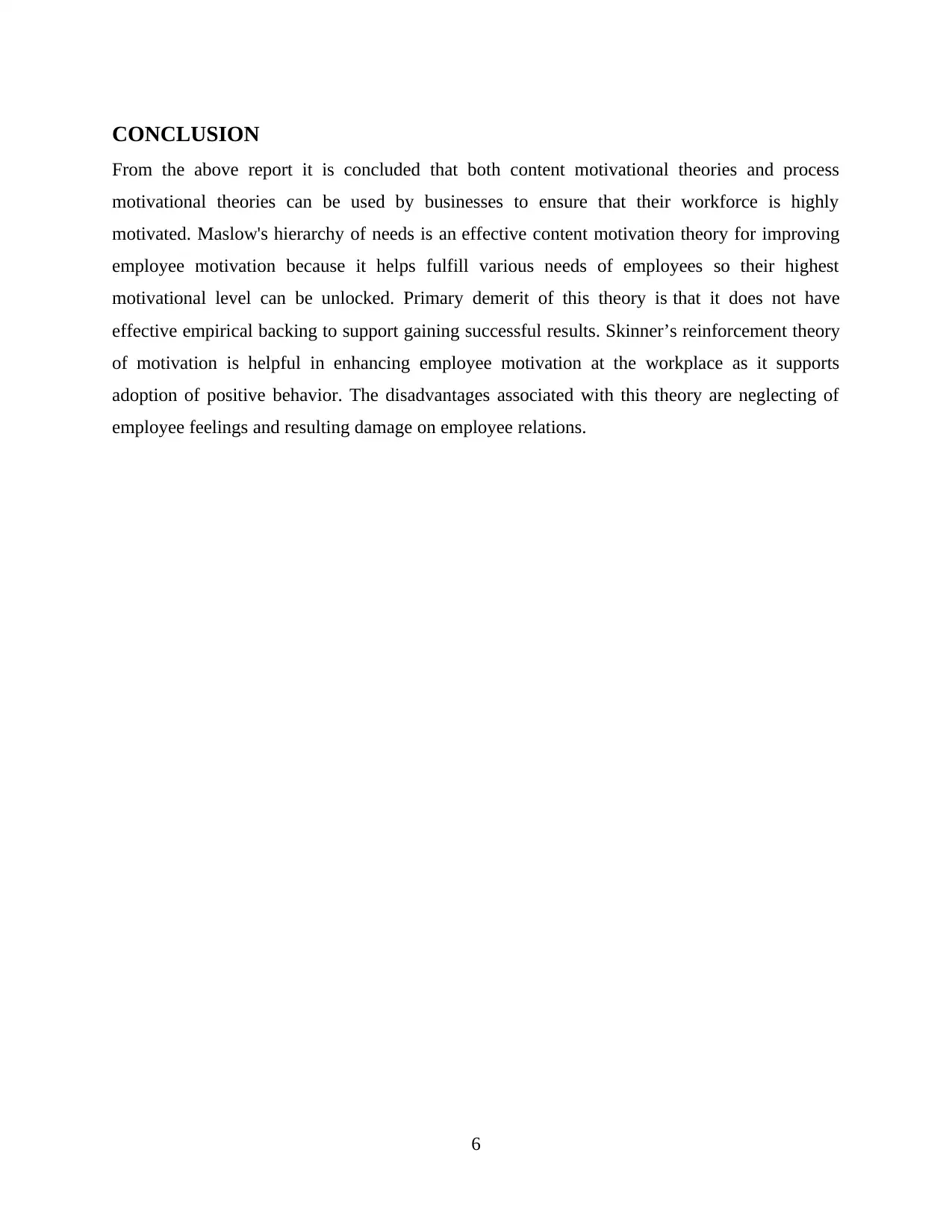
CONCLUSION
From the above report it is concluded that both content motivational theories and process
motivational theories can be used by businesses to ensure that their workforce is highly
motivated. Maslow's hierarchy of needs is an effective content motivation theory for improving
employee motivation because it helps fulfill various needs of employees so their highest
motivational level can be unlocked. Primary demerit of this theory is that it does not have
effective empirical backing to support gaining successful results. Skinner’s reinforcement theory
of motivation is helpful in enhancing employee motivation at the workplace as it supports
adoption of positive behavior. The disadvantages associated with this theory are neglecting of
employee feelings and resulting damage on employee relations.
6
From the above report it is concluded that both content motivational theories and process
motivational theories can be used by businesses to ensure that their workforce is highly
motivated. Maslow's hierarchy of needs is an effective content motivation theory for improving
employee motivation because it helps fulfill various needs of employees so their highest
motivational level can be unlocked. Primary demerit of this theory is that it does not have
effective empirical backing to support gaining successful results. Skinner’s reinforcement theory
of motivation is helpful in enhancing employee motivation at the workplace as it supports
adoption of positive behavior. The disadvantages associated with this theory are neglecting of
employee feelings and resulting damage on employee relations.
6
⊘ This is a preview!⊘
Do you want full access?
Subscribe today to unlock all pages.

Trusted by 1+ million students worldwide
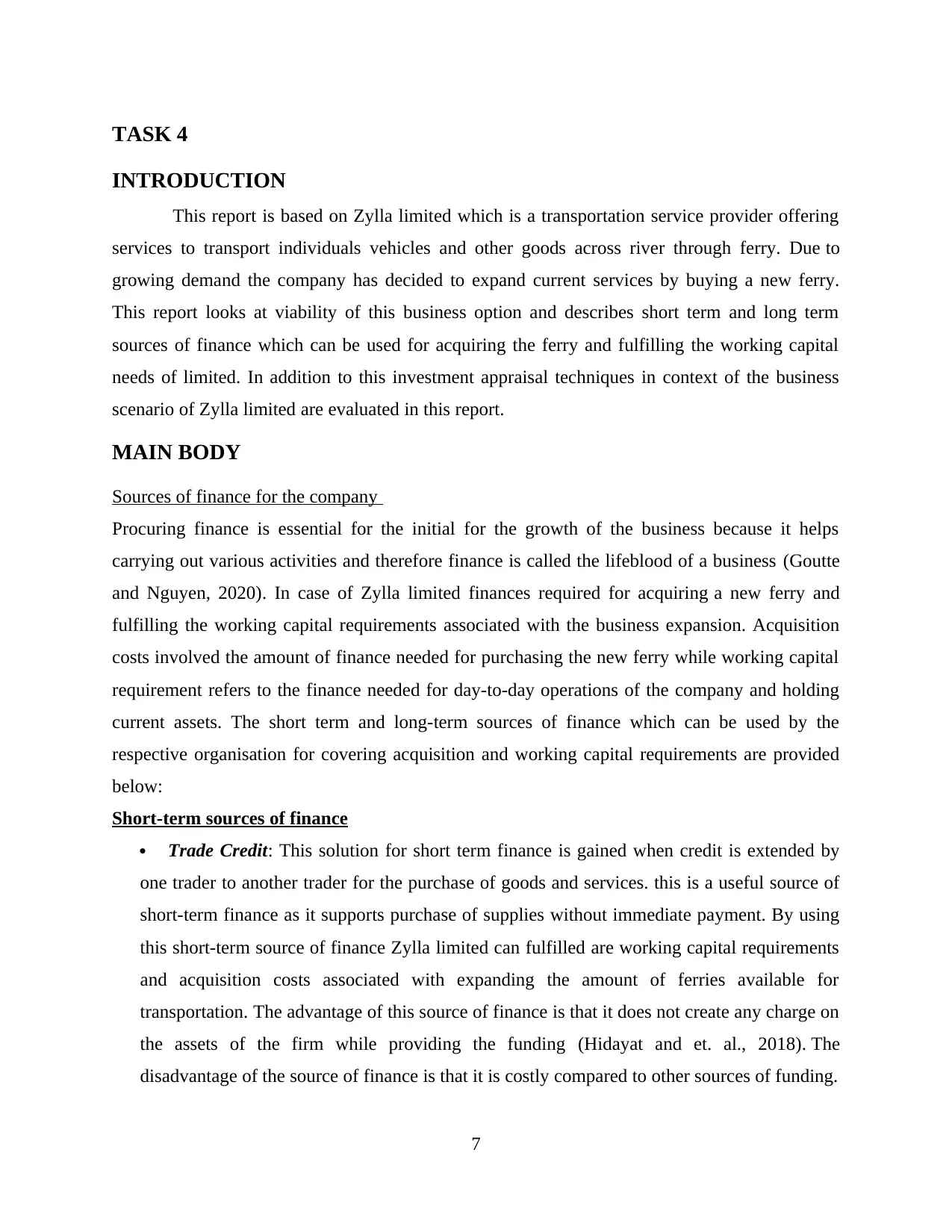
TASK 4
INTRODUCTION
This report is based on Zylla limited which is a transportation service provider offering
services to transport individuals vehicles and other goods across river through ferry. Due to
growing demand the company has decided to expand current services by buying a new ferry.
This report looks at viability of this business option and describes short term and long term
sources of finance which can be used for acquiring the ferry and fulfilling the working capital
needs of limited. In addition to this investment appraisal techniques in context of the business
scenario of Zylla limited are evaluated in this report.
MAIN BODY
Sources of finance for the company
Procuring finance is essential for the initial for the growth of the business because it helps
carrying out various activities and therefore finance is called the lifeblood of a business (Goutte
and Nguyen, 2020). In case of Zylla limited finances required for acquiring a new ferry and
fulfilling the working capital requirements associated with the business expansion. Acquisition
costs involved the amount of finance needed for purchasing the new ferry while working capital
requirement refers to the finance needed for day-to-day operations of the company and holding
current assets. The short term and long-term sources of finance which can be used by the
respective organisation for covering acquisition and working capital requirements are provided
below:
Short-term sources of finance
Trade Credit: This solution for short term finance is gained when credit is extended by
one trader to another trader for the purchase of goods and services. this is a useful source of
short-term finance as it supports purchase of supplies without immediate payment. By using
this short-term source of finance Zylla limited can fulfilled are working capital requirements
and acquisition costs associated with expanding the amount of ferries available for
transportation. The advantage of this source of finance is that it does not create any charge on
the assets of the firm while providing the funding (Hidayat and et. al., 2018). The
disadvantage of the source of finance is that it is costly compared to other sources of funding.
7
INTRODUCTION
This report is based on Zylla limited which is a transportation service provider offering
services to transport individuals vehicles and other goods across river through ferry. Due to
growing demand the company has decided to expand current services by buying a new ferry.
This report looks at viability of this business option and describes short term and long term
sources of finance which can be used for acquiring the ferry and fulfilling the working capital
needs of limited. In addition to this investment appraisal techniques in context of the business
scenario of Zylla limited are evaluated in this report.
MAIN BODY
Sources of finance for the company
Procuring finance is essential for the initial for the growth of the business because it helps
carrying out various activities and therefore finance is called the lifeblood of a business (Goutte
and Nguyen, 2020). In case of Zylla limited finances required for acquiring a new ferry and
fulfilling the working capital requirements associated with the business expansion. Acquisition
costs involved the amount of finance needed for purchasing the new ferry while working capital
requirement refers to the finance needed for day-to-day operations of the company and holding
current assets. The short term and long-term sources of finance which can be used by the
respective organisation for covering acquisition and working capital requirements are provided
below:
Short-term sources of finance
Trade Credit: This solution for short term finance is gained when credit is extended by
one trader to another trader for the purchase of goods and services. this is a useful source of
short-term finance as it supports purchase of supplies without immediate payment. By using
this short-term source of finance Zylla limited can fulfilled are working capital requirements
and acquisition costs associated with expanding the amount of ferries available for
transportation. The advantage of this source of finance is that it does not create any charge on
the assets of the firm while providing the funding (Hidayat and et. al., 2018). The
disadvantage of the source of finance is that it is costly compared to other sources of funding.
7
Paraphrase This Document
Need a fresh take? Get an instant paraphrase of this document with our AI Paraphraser
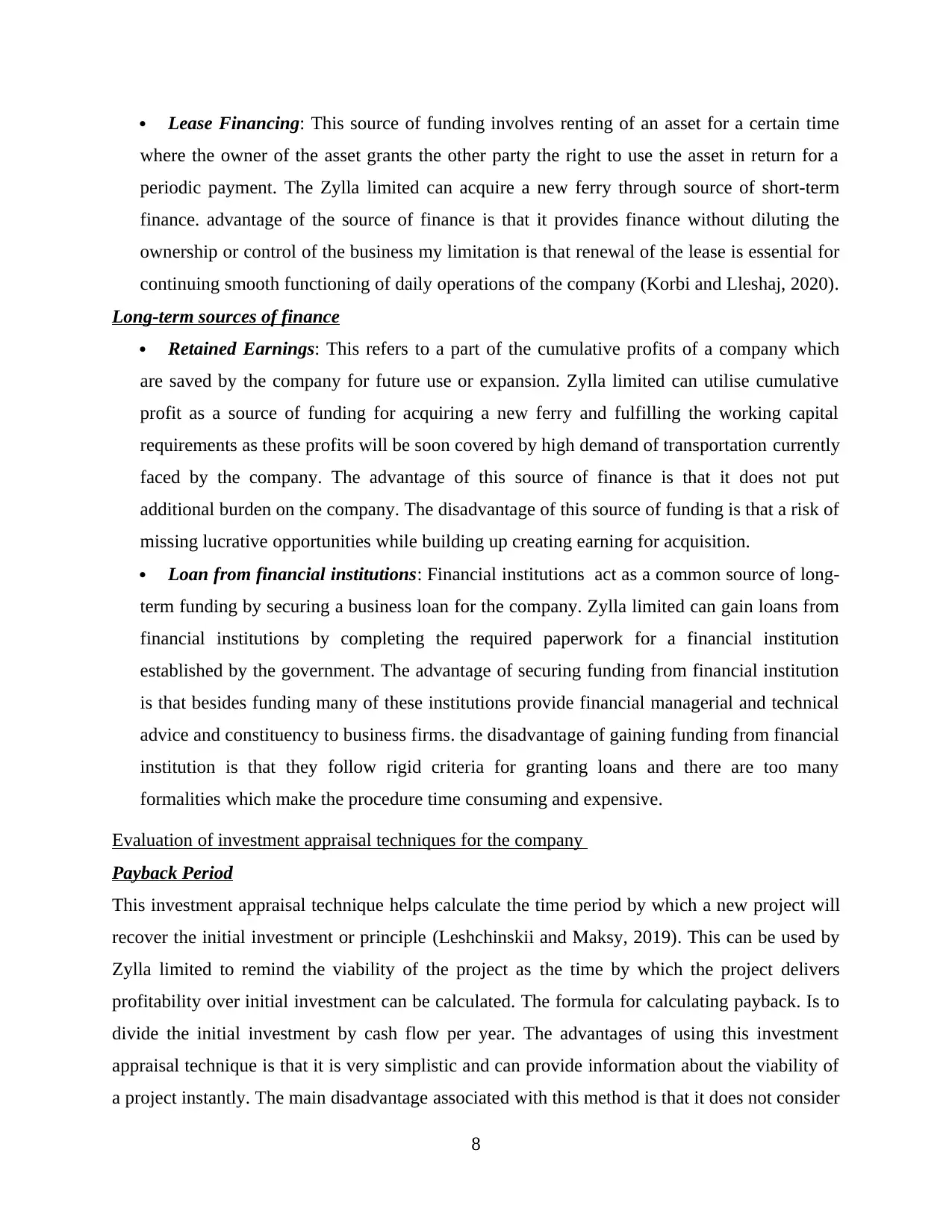
Lease Financing: This source of funding involves renting of an asset for a certain time
where the owner of the asset grants the other party the right to use the asset in return for a
periodic payment. The Zylla limited can acquire a new ferry through source of short-term
finance. advantage of the source of finance is that it provides finance without diluting the
ownership or control of the business my limitation is that renewal of the lease is essential for
continuing smooth functioning of daily operations of the company (Korbi and Lleshaj, 2020).
Long-term sources of finance
Retained Earnings: This refers to a part of the cumulative profits of a company which
are saved by the company for future use or expansion. Zylla limited can utilise cumulative
profit as a source of funding for acquiring a new ferry and fulfilling the working capital
requirements as these profits will be soon covered by high demand of transportation currently
faced by the company. The advantage of this source of finance is that it does not put
additional burden on the company. The disadvantage of this source of funding is that a risk of
missing lucrative opportunities while building up creating earning for acquisition.
Loan from financial institutions: Financial institutions act as a common source of long-
term funding by securing a business loan for the company. Zylla limited can gain loans from
financial institutions by completing the required paperwork for a financial institution
established by the government. The advantage of securing funding from financial institution
is that besides funding many of these institutions provide financial managerial and technical
advice and constituency to business firms. the disadvantage of gaining funding from financial
institution is that they follow rigid criteria for granting loans and there are too many
formalities which make the procedure time consuming and expensive.
Evaluation of investment appraisal techniques for the company
Payback Period
This investment appraisal technique helps calculate the time period by which a new project will
recover the initial investment or principle (Leshchinskii and Maksy, 2019). This can be used by
Zylla limited to remind the viability of the project as the time by which the project delivers
profitability over initial investment can be calculated. The formula for calculating payback. Is to
divide the initial investment by cash flow per year. The advantages of using this investment
appraisal technique is that it is very simplistic and can provide information about the viability of
a project instantly. The main disadvantage associated with this method is that it does not consider
8
where the owner of the asset grants the other party the right to use the asset in return for a
periodic payment. The Zylla limited can acquire a new ferry through source of short-term
finance. advantage of the source of finance is that it provides finance without diluting the
ownership or control of the business my limitation is that renewal of the lease is essential for
continuing smooth functioning of daily operations of the company (Korbi and Lleshaj, 2020).
Long-term sources of finance
Retained Earnings: This refers to a part of the cumulative profits of a company which
are saved by the company for future use or expansion. Zylla limited can utilise cumulative
profit as a source of funding for acquiring a new ferry and fulfilling the working capital
requirements as these profits will be soon covered by high demand of transportation currently
faced by the company. The advantage of this source of finance is that it does not put
additional burden on the company. The disadvantage of this source of funding is that a risk of
missing lucrative opportunities while building up creating earning for acquisition.
Loan from financial institutions: Financial institutions act as a common source of long-
term funding by securing a business loan for the company. Zylla limited can gain loans from
financial institutions by completing the required paperwork for a financial institution
established by the government. The advantage of securing funding from financial institution
is that besides funding many of these institutions provide financial managerial and technical
advice and constituency to business firms. the disadvantage of gaining funding from financial
institution is that they follow rigid criteria for granting loans and there are too many
formalities which make the procedure time consuming and expensive.
Evaluation of investment appraisal techniques for the company
Payback Period
This investment appraisal technique helps calculate the time period by which a new project will
recover the initial investment or principle (Leshchinskii and Maksy, 2019). This can be used by
Zylla limited to remind the viability of the project as the time by which the project delivers
profitability over initial investment can be calculated. The formula for calculating payback. Is to
divide the initial investment by cash flow per year. The advantages of using this investment
appraisal technique is that it is very simplistic and can provide information about the viability of
a project instantly. The main disadvantage associated with this method is that it does not consider
8

the clash close after the payback and two projects with the same Payback period ccannot be
considered equally good.
Profitability Index
Financial attractiveness of a project can be determined with the help of profitability index. The
formula for this investment appraisal technique is calculated through division of current value of
future expected cash flows by the starting investment amount of the business activity (Marak,
and Pillai, 2019). Zylla Limited can utilise this investment appraisal technique if the project is
highly profitable or not. The advantage of using this investment appraiser technique is that It
supports selection of budget friendly business prospects while the disadvantages that it ignores
sunk cost of the project.
9
considered equally good.
Profitability Index
Financial attractiveness of a project can be determined with the help of profitability index. The
formula for this investment appraisal technique is calculated through division of current value of
future expected cash flows by the starting investment amount of the business activity (Marak,
and Pillai, 2019). Zylla Limited can utilise this investment appraisal technique if the project is
highly profitable or not. The advantage of using this investment appraiser technique is that It
supports selection of budget friendly business prospects while the disadvantages that it ignores
sunk cost of the project.
9
⊘ This is a preview!⊘
Do you want full access?
Subscribe today to unlock all pages.

Trusted by 1+ million students worldwide
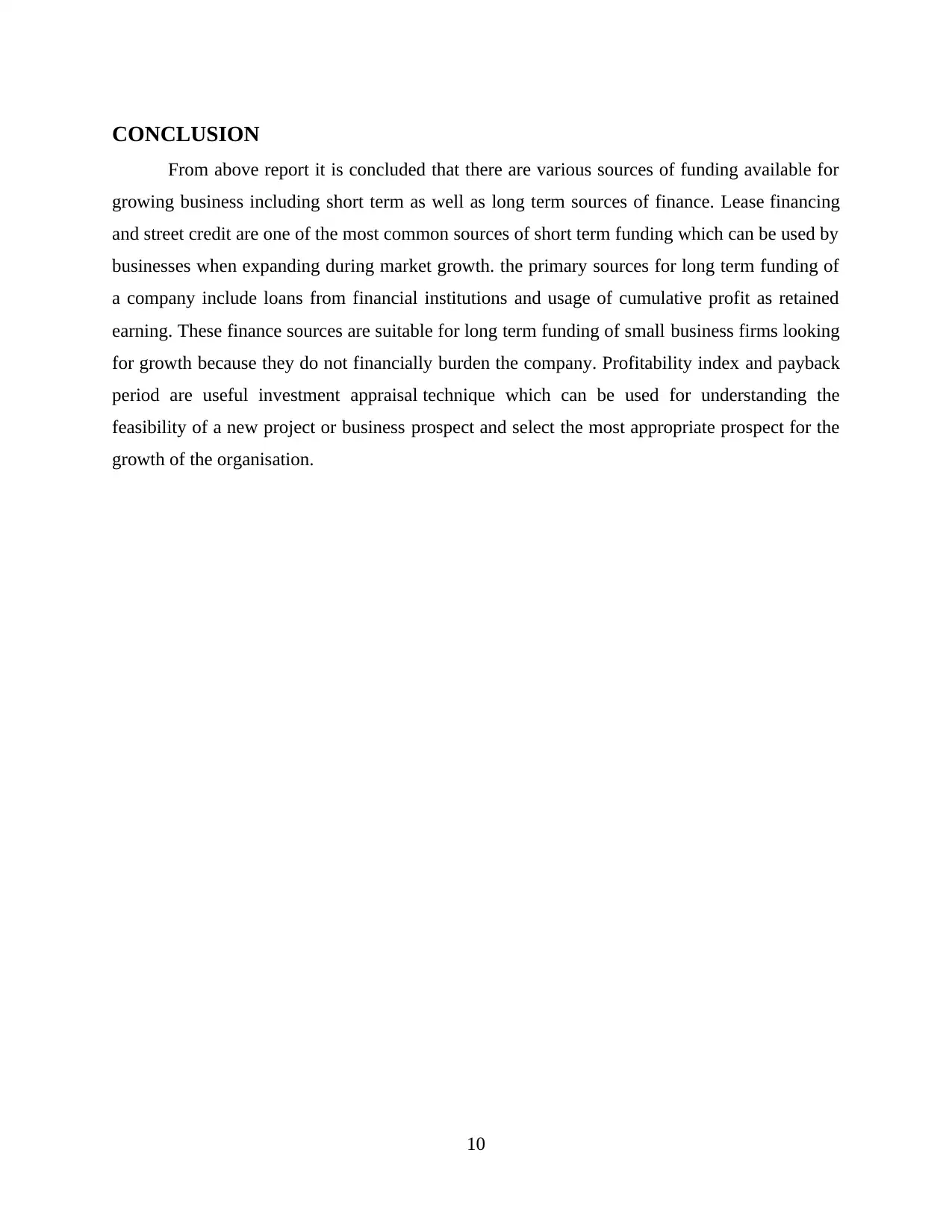
CONCLUSION
From above report it is concluded that there are various sources of funding available for
growing business including short term as well as long term sources of finance. Lease financing
and street credit are one of the most common sources of short term funding which can be used by
businesses when expanding during market growth. the primary sources for long term funding of
a company include loans from financial institutions and usage of cumulative profit as retained
earning. These finance sources are suitable for long term funding of small business firms looking
for growth because they do not financially burden the company. Profitability index and payback
period are useful investment appraisal technique which can be used for understanding the
feasibility of a new project or business prospect and select the most appropriate prospect for the
growth of the organisation.
10
From above report it is concluded that there are various sources of funding available for
growing business including short term as well as long term sources of finance. Lease financing
and street credit are one of the most common sources of short term funding which can be used by
businesses when expanding during market growth. the primary sources for long term funding of
a company include loans from financial institutions and usage of cumulative profit as retained
earning. These finance sources are suitable for long term funding of small business firms looking
for growth because they do not financially burden the company. Profitability index and payback
period are useful investment appraisal technique which can be used for understanding the
feasibility of a new project or business prospect and select the most appropriate prospect for the
growth of the organisation.
10
Paraphrase This Document
Need a fresh take? Get an instant paraphrase of this document with our AI Paraphraser
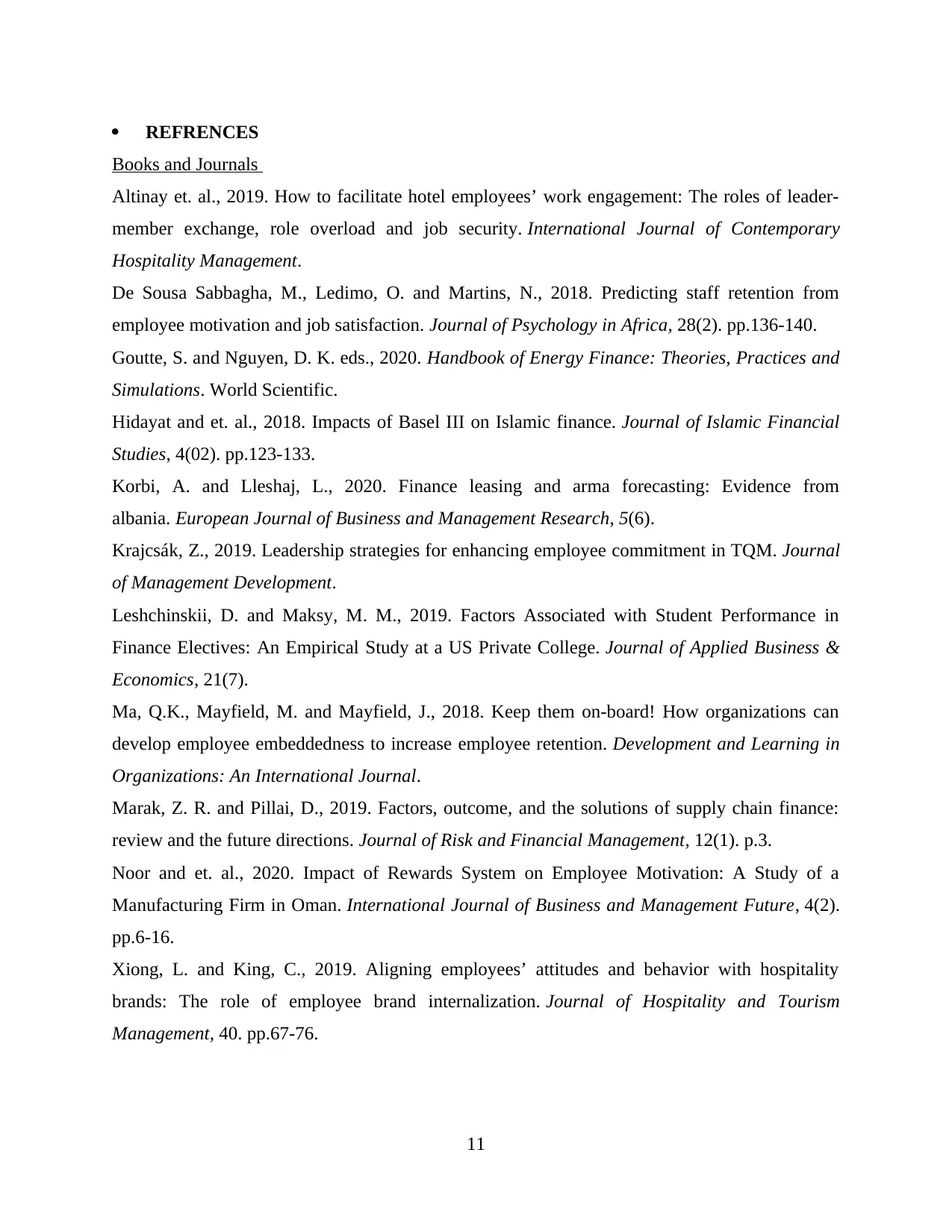
REFRENCES
Books and Journals
Altinay et. al., 2019. How to facilitate hotel employees’ work engagement: The roles of leader-
member exchange, role overload and job security. International Journal of Contemporary
Hospitality Management.
De Sousa Sabbagha, M., Ledimo, O. and Martins, N., 2018. Predicting staff retention from
employee motivation and job satisfaction. Journal of Psychology in Africa, 28(2). pp.136-140.
Goutte, S. and Nguyen, D. K. eds., 2020. Handbook of Energy Finance: Theories, Practices and
Simulations. World Scientific.
Hidayat and et. al., 2018. Impacts of Basel III on Islamic finance. Journal of Islamic Financial
Studies, 4(02). pp.123-133.
Korbi, A. and Lleshaj, L., 2020. Finance leasing and arma forecasting: Evidence from
albania. European Journal of Business and Management Research, 5(6).
Krajcsák, Z., 2019. Leadership strategies for enhancing employee commitment in TQM. Journal
of Management Development.
Leshchinskii, D. and Maksy, M. M., 2019. Factors Associated with Student Performance in
Finance Electives: An Empirical Study at a US Private College. Journal of Applied Business &
Economics, 21(7).
Ma, Q.K., Mayfield, M. and Mayfield, J., 2018. Keep them on-board! How organizations can
develop employee embeddedness to increase employee retention. Development and Learning in
Organizations: An International Journal.
Marak, Z. R. and Pillai, D., 2019. Factors, outcome, and the solutions of supply chain finance:
review and the future directions. Journal of Risk and Financial Management, 12(1). p.3.
Noor and et. al., 2020. Impact of Rewards System on Employee Motivation: A Study of a
Manufacturing Firm in Oman. International Journal of Business and Management Future, 4(2).
pp.6-16.
Xiong, L. and King, C., 2019. Aligning employees’ attitudes and behavior with hospitality
brands: The role of employee brand internalization. Journal of Hospitality and Tourism
Management, 40. pp.67-76.
11
Books and Journals
Altinay et. al., 2019. How to facilitate hotel employees’ work engagement: The roles of leader-
member exchange, role overload and job security. International Journal of Contemporary
Hospitality Management.
De Sousa Sabbagha, M., Ledimo, O. and Martins, N., 2018. Predicting staff retention from
employee motivation and job satisfaction. Journal of Psychology in Africa, 28(2). pp.136-140.
Goutte, S. and Nguyen, D. K. eds., 2020. Handbook of Energy Finance: Theories, Practices and
Simulations. World Scientific.
Hidayat and et. al., 2018. Impacts of Basel III on Islamic finance. Journal of Islamic Financial
Studies, 4(02). pp.123-133.
Korbi, A. and Lleshaj, L., 2020. Finance leasing and arma forecasting: Evidence from
albania. European Journal of Business and Management Research, 5(6).
Krajcsák, Z., 2019. Leadership strategies for enhancing employee commitment in TQM. Journal
of Management Development.
Leshchinskii, D. and Maksy, M. M., 2019. Factors Associated with Student Performance in
Finance Electives: An Empirical Study at a US Private College. Journal of Applied Business &
Economics, 21(7).
Ma, Q.K., Mayfield, M. and Mayfield, J., 2018. Keep them on-board! How organizations can
develop employee embeddedness to increase employee retention. Development and Learning in
Organizations: An International Journal.
Marak, Z. R. and Pillai, D., 2019. Factors, outcome, and the solutions of supply chain finance:
review and the future directions. Journal of Risk and Financial Management, 12(1). p.3.
Noor and et. al., 2020. Impact of Rewards System on Employee Motivation: A Study of a
Manufacturing Firm in Oman. International Journal of Business and Management Future, 4(2).
pp.6-16.
Xiong, L. and King, C., 2019. Aligning employees’ attitudes and behavior with hospitality
brands: The role of employee brand internalization. Journal of Hospitality and Tourism
Management, 40. pp.67-76.
11
1 out of 11
Related Documents
Your All-in-One AI-Powered Toolkit for Academic Success.
+13062052269
info@desklib.com
Available 24*7 on WhatsApp / Email
![[object Object]](/_next/static/media/star-bottom.7253800d.svg)
Unlock your academic potential
Copyright © 2020–2025 A2Z Services. All Rights Reserved. Developed and managed by ZUCOL.





